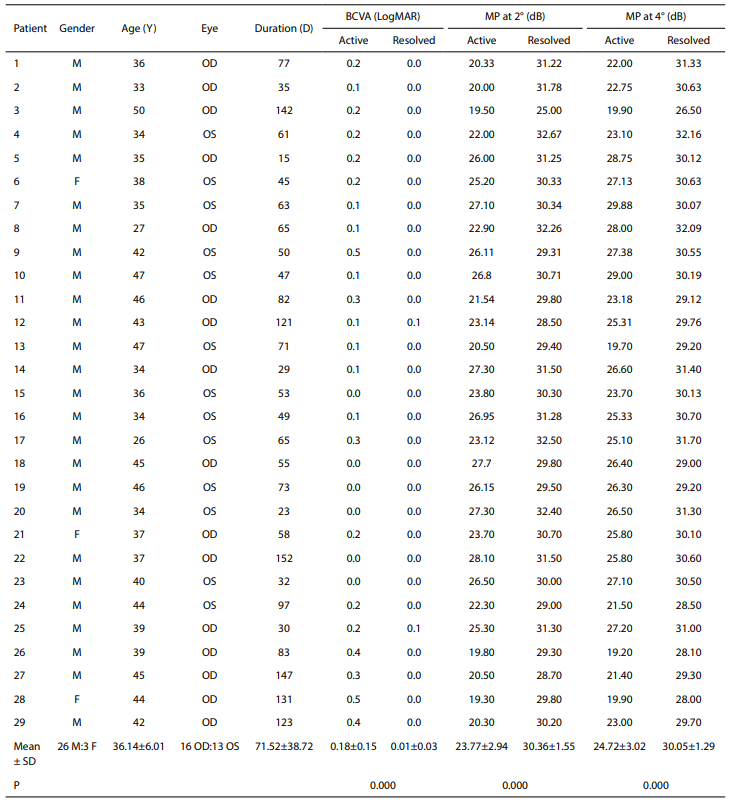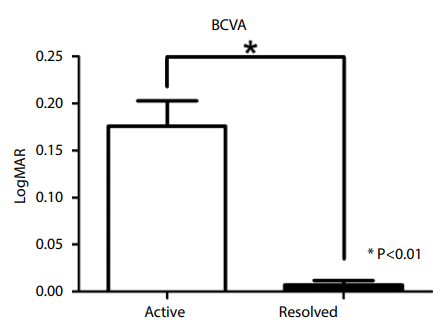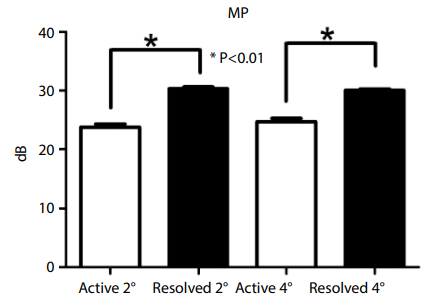1、Wang M, Munch IC, Hasler PW, et al. Central serous chorioretinopathy. Acta Ophthalmol 2008;86:126-45.
2、Eandi CM, Ober M, Iranmanesh R, et al. Acute central serous chorioretinopathy and fundus autoff uorescence. Retina 2005;25:989-93.
3、Fine HF, Ober MD, Hariprasad SM. Current concepts in managing central serous chorioretinopathy. Ophthalmic Surg Lasers Imaging Retina 2014;45:9-13.
4、Senturk F, Karacorlu M, Ozdemir H, et al. Microperimetric changes after photodynamic therapy for central serous chorioretinopathy. Am J Ophthalmol 2011;151:303-9.e1
5、Fujita K, Shinoda K, Matsumoto CS, et al. Microperimetric evaluation of chronic central serous chorioretinopathy after half-dose photodynamic therapy. Clin Ophthalmol 2012;6:1681-7.
6、Kim JY, Park HS, Kim SY. Short-term efficacy of subthreshold micropulse yellow laser (577-nm) photocoagulation for chronic central serous chorioretinopathy. Graefes Arch Clin Exp Ophthalmol 2015;253:2129-35.
7、Ojima Y, Tsujikawa A, Hangai M, et al. Retinal sensitivity measured with the micro perimeter 1 after resolution of central serous chorioretinopathy. Am J Ophthalmol
2008;146:77-84.
8、Eandi CM, Piccolino FC, Alovisi C, et al. Correlation between fundus autoff uorescence and central visual function in chronic central serous chorioretinopathy. Am J Ophthalmol 2015;159:652-8.
9、Lim JW, Kang SW, Kim YT, et al. Comparative study of patients with central serous chorioretinopathy undergoing focal laser photocoagulation or photodynamic therapy. Br
J Ophthalmol 2011;95:514-7.
10、Chung HW, Yun CM, Kim JT, et al. Retinal sensitivity assessed by microperimetry and corresponding retinal structure and thickness in resolved central serous chorioretinopathy. Eye (Lond) 2014;28:1223-30.
11、Oh J, Kim SW, Kwon SS, et al. Correlation of fundus autoff uorescence gray values with vision and microperimetry in resolved central serous chorioretinopathy. Invest Ophthalmol Vis Sci 2012;53:179-84.
12、Kim SW, Oh J, Huh K. Correlations among various functional and morphological tests in resolved central serous chorioretinopathy. Br J Ophthalmol 2012;96:350-5.
13、Ozdemir H, Karacorlu SA, Senturk F, et al. Assessment of macular function by microperimetry in unilateral resolved central serous chorioretinopathy. Eye (Lond) 2008;22:204-8.
14、Liew G, Quin G, Gillies M, et al. Central serous chorioretinopathy: a review of epidemiology and pathophysiology. Clin Experiment Ophthalmol 2013;41:201-14.
15、Roisman%20L%2C%20Ribeiro%20JC%2C%20Fechine%20FV%2C%20et%20al.%20Does%20microperimetry%20have%20a%20prognostic%20value%20in%20central%20serous%20chorioretinopathy%3F%20Retina%202014%3B34%3A713-8.
16、Ozdemir H, Senturk F, Karacorlu M, et al. Macular sensitivity in eyes with central serous chorioretinopathy. Eur J Ophthalmol 2008;18:799-804.
17、Schmidt-Erfurth UM, Elsner H, Terai N, et al. Eff ects of verteporff n therapy on central visual ff eld function. Ophthalmology 2004;111:931-9.
18、Koytak A, Erol K, Coskun E, et al. Fluorescein angiography-guided photodynamic therapy with half-dose verteporff n for chronic central serous chorioretinopathy. Retina 2010;30:1698-703.
19、Lai TY, Chan WM, Li H, et al. Safety enhanced photodynamic therapy with half dose verteporff n for chronic central serous chorioretinopathy: a short term pilot study. Br J Ophthalmol 2006;90:869-74.
20、Reibaldi M, Cardascia N, Longo A, et al. Standard-ff uence versus low-ff uence photodynamic therapy in chronic central serous chorioretinopathy: a nonrandomized clinical trial. Am J Ophthalmol 2010;149:307-315.e2.
21、Williams MA, Mulholland C, Silvestri G. Photodynamic therapy for central serous chorioretinopathy using a reduced dose of verteporff n. Can J Ophthalmol 2008;43:123.








